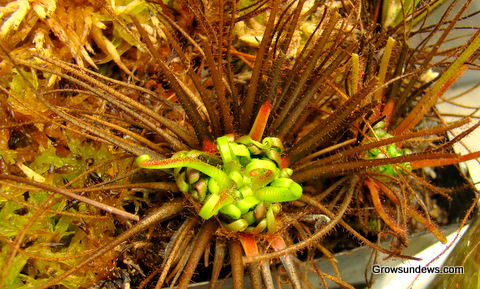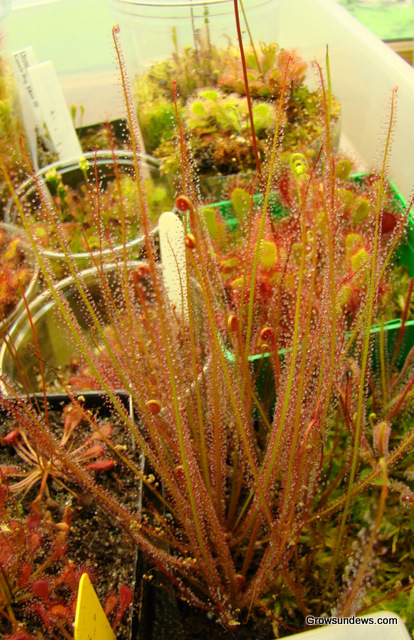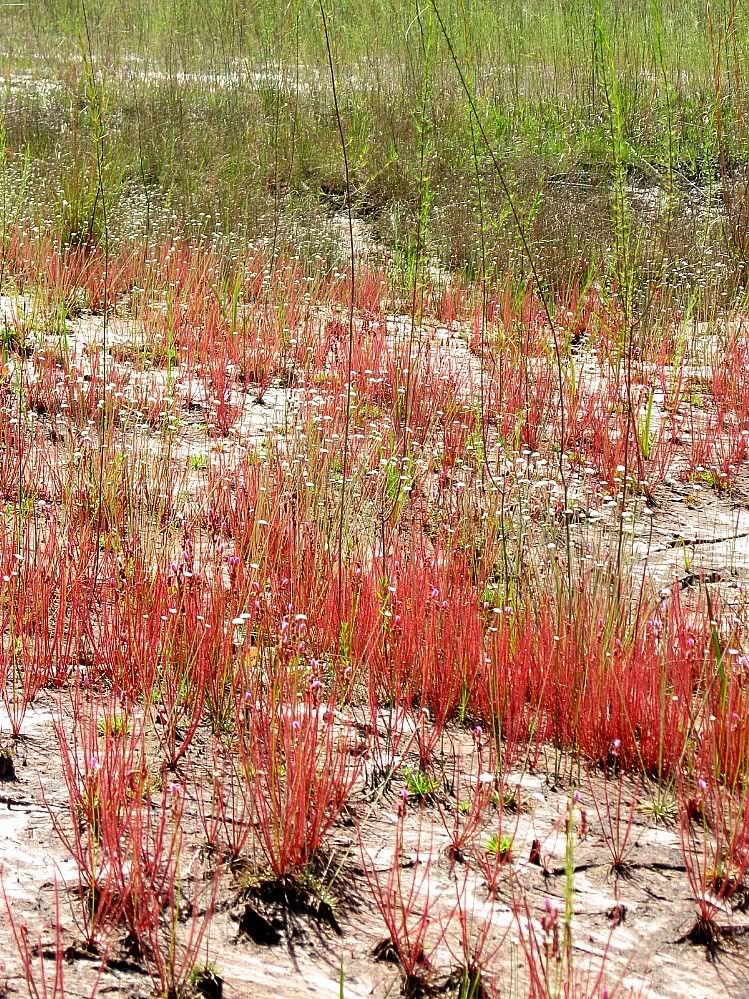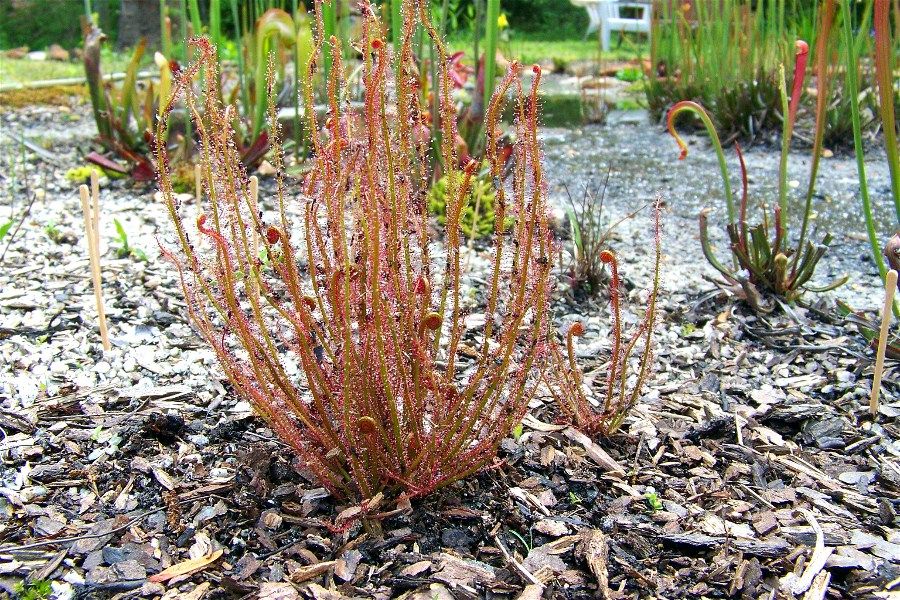|
|
Post by radar357 on Oct 9, 2010 0:02:15 GMT
I want to plant some red D. filiformis seed again. Last efforts produced no seedlings. Tried damp cp mix indoors under lights, and outdoors under full sun, with no results. Also was told that red does not need to be stratified, is this true? Had lots of Byblis liniflora pop up everywhere, even in the Drosera filiformis pots but no red Drosera filiformis? Thanks, Randy
|
|
|
|
Post by jesser on Oct 9, 2010 10:05:37 GMT
Tried damp cp mix indoors under lights, and outdoors under full sun, with no results. Also was told that red does not need to be stratified, is this true? I received a batch of seeds labeled "D. filiformis red form" in January 2009 and could germinate them without stratification. The seeds were obtained from a grower who grows his plants in a frost-free heated greenhouse in winter. As this species is not winter hardy (in Germany) the seeds should germinate without cold stratification and so it was. For me the time for germination in an indoor terrarium (20-24°C, 14 hours photoperiod under lights) was less than the time for germination on a south-west facing window sill (18-20°C, sowing date mid of January), but in both cases there was a good germination without stratification. |
|
sundewman
Full Member
Happy Growing!
Posts: 235
|
Post by sundewman on Oct 9, 2010 21:24:41 GMT
There seems to be a mix of seeds going around, some labeled "Florida All-Red" and "Florida Red". Based on what I've read (quote directly below), the "Florida Red" does need stratification, while the Florida All-Red" doesn't. However, it seems that either there has been a lack of detailed labeling...OR is it just that the "giant" ("Florida Red") form does not need cold stratification either? Here is a quote from the ICPS Drosera filiformis page: "The "Giant" form of D. filiformis is larger than the New Jersey form but smaller than D. tracyi. This has been distributed as D. filiformis "Florida" and D. filiformis "Florida Red". It should not be confused with the "Florida All Red" form as it forms hybernacula and requires a cool dormancy" I have grown the "Florida All-Red" form from seed without cold stratification and had good germination rates, as jesser experienced. The seed was pretty fresh, though. However, in order to get them to maturity indoors, I had to feed it a ton. Otherwise, they tend to stay the same miniscule size. I've had to grow most of my sundews indoors year-round for the past 2 years, since I'm not around to check on them consistently. Dormancy with the D. filiformis "Florida All-Red" form was interesting- If the temps stay around 70 or higher all year, this plant will not go dormant, and continues to grow as normal. But last year, as the temperature dropped from 85 F indoors in the summer to 65 F indoors, D. filiformis "Florida All-Red" began to go into dormancy, forming hibernaculum (I didn't change the photoperiod at all for the whole year, leaving it at a constant 16 hours):  I left them in their pot with the same amount of water that I normally use for the other "water-loving" sundews in the same tray (water 1/4 to halfway up the pot or higher). Surprisingly enough, the hibernacula didn't rot in these conditions, and stayed safe all winter long in the tray, and then it came out of dormancy as normal in the spring, when temps rose to 70 F or so. Here's an old pic of the plants:  |
|
|
|
Post by radar357 on Oct 10, 2010 6:24:39 GMT
Thanks for the great feedback. My reds have formed hibernacula now about the size of a dime, same with the Drosera trayci. The giants have quarter size hibes. The photo is of one of the reds, and a Drosera trayci that was taken in August this year. Thanks again, Randy Attachments:
|
|
|
|
Post by Randy Zerr on Oct 10, 2010 15:15:40 GMT
The natural habitat for these plants is not far from me and both the extra large type and smaller plants grow in the same type habitat. Primarily pure, fine white silica sand. Some locales have some organic debris mixed in the sand. Usually there is a natural spring seep that keeps the soil damp, but often they grow at the edges of ponds that periodically flood. They grow out in full sun and along with the white sand it is very bright, squinting eye watering bright. Summer highs are in the low - mid 90's F (35C, maybe a little higher) almost every day and winter lows occasionally below freezing. Surely ground heat helps the hibernacula survive when it's in the low 20's or upper teens. Temperatures that low are very rare.  |
|
|
|
Post by radar357 on Oct 10, 2010 16:37:43 GMT
Thanks Randy that helps alot, nice photo also. When i was CP hunting in Southern Miss. , I found D. brevifolia that was growing in similar conditions. The sand was just dark red with hundreds of the little buggers next to a ponds edge.
|
|
sundewman
Full Member
Happy Growing!
Posts: 235
|
Post by sundewman on Oct 11, 2010 0:45:28 GMT
Cool picture, Randy! It's always great to see colonies of them, like that.
|
|
|
|
Post by mbfmark on May 2, 2012 2:08:31 GMT
I have a large outdoor bog garden in the extreme western tip of SC, at the base of the Blue Ridge Mtns (zone 7B - usually) - I have successfully grown the "Florida All-Red" form of D. filiformis through winter nights routinely in the 20's and occasionally in the teens. In early January, the entire bog froze solid for a few days. The plants were given no protection all winter and survived just fine, even when the hibernacula were frost heaved out of the ground and hand to be pushed back down. Here is a photo taken April 15, 2012 of a couple of the plants leafing back out.  This form will produce seed much of the season and some seedlings will sprout in the sandy/gravelly parts of the bog without stratification. Even some tiny seedlings survived the winter. Right now, many additional seedlings are popping up from seed that overwintered. Last fall, worried about the plants not surviving the winter, I took in some of the seedlings and grew them under lights. I planted them back out this spring, but apparently the cool nights sent some of them into a dormancy, so they are just sitting there as hibernacula even though our highs are now in the 80's quite a bit. So my plan sort of backfired in a way, though some are now showing signs of growing again. Not that it matters since there are hundreds, if not thousands of seedlings coming up. I also tried to sprout some of the seed on spaghnum in my orchid greenhouse this winter. Only a few plants sprouted. But when I "planted" the clump of sphagnum they were growing on out in the bog a few weeks ago, whoa! - suddenly all the remaining seed sprouted so the entire surface is red with them! I just love this sundew! I think I also have a hybrid that arose between it and D. tracyi. I'm watching it to make sure - but it looks large like D. tracyi, with lots of red, but not quite as much as the "Florida All-Red". I'll post a photo when I'm sure. |
|
Richard Davion
Full Member
Having-Problems Taking-OUT Another [4]-Years-of-MEMBERSHIP Why-Does-It Have-To-Be Soo-'Hard' Fellahs
Posts: 219
|
Post by Richard Davion on May 2, 2012 5:37:29 GMT
|
|







